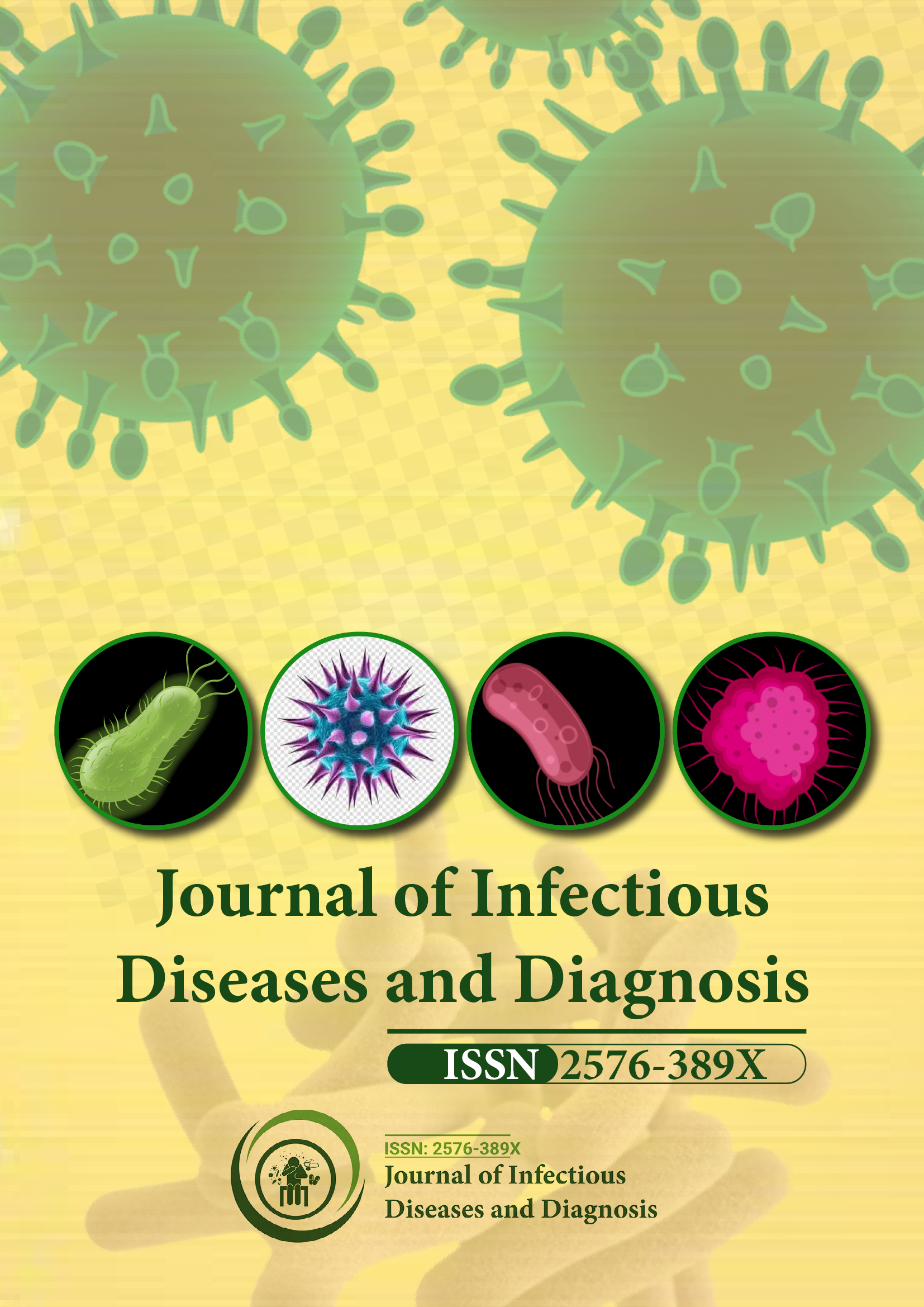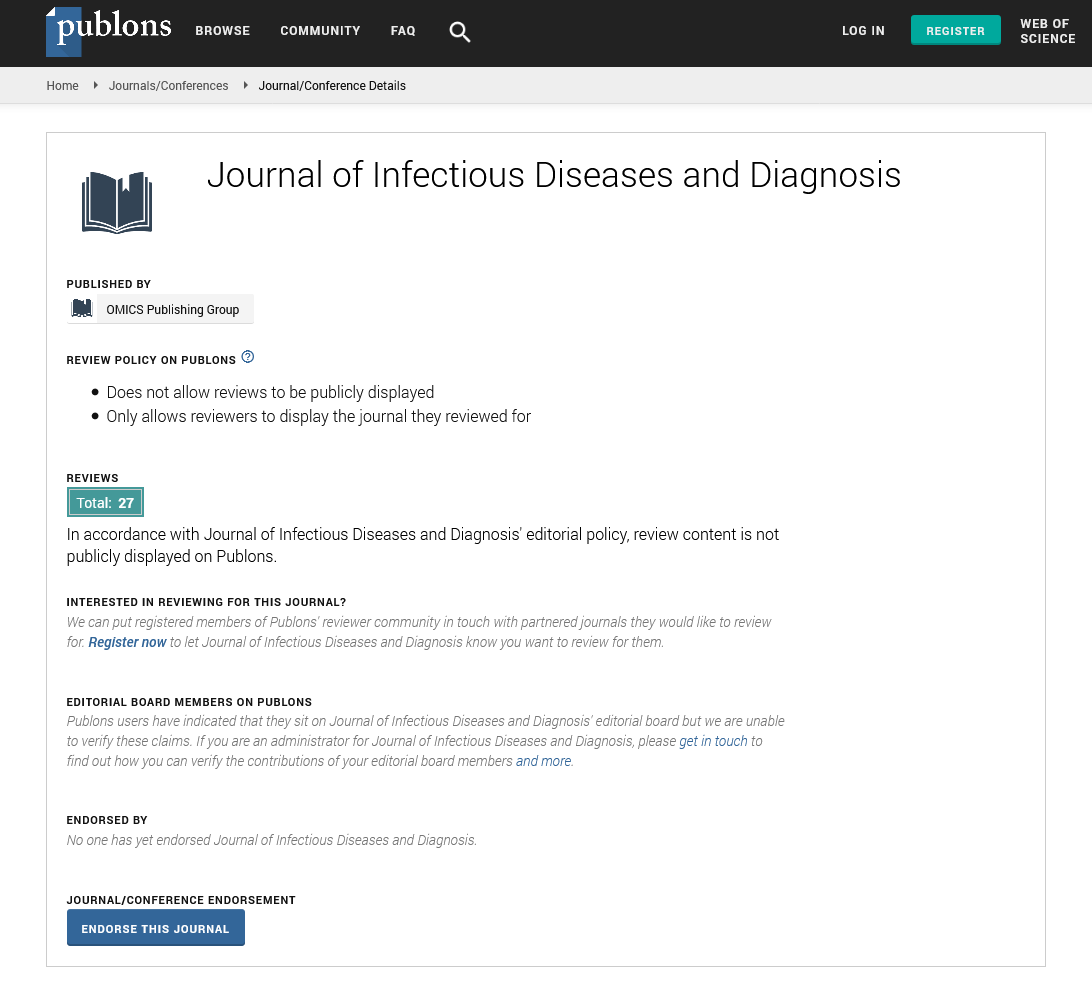Indexed In
- RefSeek
- Hamdard University
- EBSCO A-Z
- Publons
- Euro Pub
- Google Scholar
Useful Links
Share This Page
Journal Flyer

Open Access Journals
- Agri and Aquaculture
- Biochemistry
- Bioinformatics & Systems Biology
- Business & Management
- Chemistry
- Clinical Sciences
- Engineering
- Food & Nutrition
- General Science
- Genetics & Molecular Biology
- Immunology & Microbiology
- Medical Sciences
- Neuroscience & Psychology
- Nursing & Health Care
- Pharmaceutical Sciences
Perspective - (2025) Volume 10, Issue 3
A Novel Loop-Mediated Isothermal Amplification (LAMP) Assay for the Detection of Leptospira in Febrile Patients
Chris Williams*Received: 30-Apr-2025, Manuscript No. JIDD-25-29297; Editor assigned: 02-May-2025, Pre QC No. JIDD-25-29297 (PQ); Reviewed: 16-May-2025, QC No. JIDD-25-29297; Revised: 23-May-2025, Manuscript No. JIDD-25-29297 (R); Published: 30-May-2025, DOI: 10.35248/2576-389X.25.10.332
Description
Leptospirosis is a globally distributed zoonotic disease that presents with a wide spectrum of clinical symptoms, ranging from mild fever to severe organ dysfunction. It often mimics other tropical febrile illnesses such as dengue, malaria, or typhoid, especially in its early stages, leading to misdiagnosis and delayed treatment. Early detection of Leptospira spp., the causative organisms, is essential for initiating timely therapy and reducing complications. However, conventional diagnostic techniques, including microscopic agglutination testing and culture, are time-consuming, technically demanding and not feasible in most primary healthcare settings. Polymerase Chain Reaction (PCR) provides greater sensitivity but relies on sophisticated equipment and trained personnel, which limits its utility in rural or resource-limited environments. To address these challenges, this study evaluates a novel Loop-Mediated Isothermal Amplification (LAMP) assay developed for rapid, fieldlevel detection of Leptospira directly from clinical specimens.
The study was conducted across four hospitals in endemic regions during the monsoon and immediate post-monsoon periods when leptospirosis cases typically surge. A total of 600 patients presenting with acute undifferentiated febrile illness were enrolled. All participants underwent clinical evaluation, blood collection and laboratory testing. Whole blood samples were subjected to standard PCR testing, Microscopic Agglutination Testing (MAT) and the new LAMP assay. The performance of the LAMP assay was assessed in terms of sensitivity, specificity, ease of use, turnaround time and applicability in decentralized settings.
The LAMP assay was designed to amplify a conserved gene segment of the Leptospira genome and utilized a simple water bath or portable heating block maintained at 65°C. The entire procedure, from sample preparation to result interpretation, was completed in under 45 minutes. Positive results were indicated by a color change visible to the naked eye, eliminating the need for specialized detection equipment. This feature made it particularly suitable for use in field clinics or peripheral hospitals.
Of the 600 patients, 158 were confirmed positive for leptospirosis by PCR. The LAMP assay correctly identified 148 of these cases, yielding a sensitivity of 93.7%. Among the 442 PCR-negative cases, the LAMP assay produced 12 false positives, resulting in a specificity of 97.3%. The MAT test, in comparison, showed a lower sensitivity of 68.2% but similar specificity. Notably, LAMP was able to detect Leptospira DNA in several cases where MAT was negative, likely due to early-stage infection when antibodies had not yet developed. These findings suggest that LAMP may be more suitable for diagnosing patients in the early, acute phase of illness.
The assay also performed well under varying operational conditions. Laboratory staff with minimal molecular biology training were able to conduct the test successfully after a short orientation. No cold chain was required for reagents and the use of lyophilized reaction mixes further improved field applicability. Additionally, unlike PCR, the LAMP assay was less affected by minor sample degradation or inconsistent storage, making it a reliable choice for real-world deployment in rural areas. A significant advantage of this LAMP method was its impact on patient care. In facilities where results were available within an hour, clinicians could begin antibiotic treatment during the same visit. Among LAMP-positive patients who received early therapy, a reduction in symptom duration and hospitalization rates was observed, although this observation was not part of the study’s primary analysis. In contrast, patients who underwent traditional testing experienced delays of up to three days before a confirmed diagnosis, during which treatment was often empirical and inconsistent.
The study also examined the cost implications of introducing the LAMP assay at the primary healthcare level. Initial estimates suggest that per-test costs are comparable to or slightly lower than PCR, especially when considering the reduced equipment and infrastructure needs. Bulk procurement and localized production of reagents could further decrease costs, enabling wider adoption in endemic regions. When integrated with existing fever management protocols, LAMP offers a practical diagnostic enhancement with minimal disruption. Challenges encountered during implementation included the need for precise temperature control and occasional ambiguity in color change interpretation, particularly under poor lighting conditions. These limitations can be addressed through simple adaptations such as solar-powered heating devices and standardized color charts. Additionally, expanding the assay to a multiplex format to detect other common febrile pathogens could improve its utility in differential diagnosis scenarios.
The adoption of this LAMP assay aligns well with broader efforts to decentralize diagnostics and improve infectious disease management at the community level. Early and accurate detection of leptospirosis not only benefits individual patient outcomes but also reduces transmission risks and supports timely public health responses during seasonal outbreaks. The ability to distinguish leptospirosis from clinically similar illnesses reduces inappropriate antibiotic use and helps conserve antimicrobial effectiveness.
In conclusion, the newly developed LAMP assay offers a promising solution for the rapid diagnosis of leptospirosis in febrile patients, especially in settings where access to traditional molecular diagnostics is limited. Its high sensitivity, specificity and short turnaround time make it suitable for use in both hospital and field environments. By enabling early diagnosis and treatment, this assay contributes to improved patient care and better disease control in endemic areas. While some logistical challenges remain, these can be addressed with minor technological adjustments and adequate training. Incorporating LAMP into fever screening programs holds strong potential to close diagnostic gaps and reduce the burden of leptospirosis in vulnerable populations.
Citation: Williams C (2025). A Novel Loop-Mediated Isothermal Amplification (LAMP) Assay for the Detection of Leptospira in Febrile Patients. J Infect Dis Diagn. 10:332.
Copyright: © 2025 Williams C. This is an open-access article distributed under the terms of the Creative Commons Attribution License, which permits unrestricted use, distribution, and reproduction in any medium, provided the original author and source are credited.

